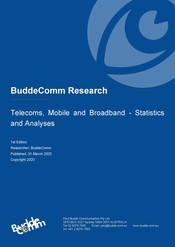2016 Latin America - Telecoms, Mobile and Broadband Forecasts

Last updated: 28 Mar 2017 Update History
Report Status: Archived
Report Pages: 37
Analyst: Henry Lancaster
Publication Overview
Providing a series of forecasts for subscriber growth in an extensive range of markets in Latin America, this market report predominantly covers the fixed line, broadband and mobile subscriber market segments. This edition covers 15 countries across the region.
The countries covered in this report include:
Argentina, Bolivia, Brazil, Chile, Columbia, Dominican Republic, Ecuador, Jamaica, Mexico, Panama, Paraguay, Peru, Puerto Rico, Uruguay, Venezuela.
Researchers:- Henry Lancaster
Current publication:- March 2017 (14th Edition)
Executive Summary
Latin America’s focus on mobile broadband showing dividends
Although the Latin American and Caribbean region covers a wide range of countries, the telecoms sector within the region is broadly similar in terms of penetration of services and market maturity. Some countries, in particular Brazil and Venezuela, are struggling with a prolonged economic downturn which has grievously affected the ability of local telcos to fund network investment. On the whole, though, the size of the overall market in the region, and its potential for ongoing growth, continues to attract investment from international telcos and vendors.
The results of these investments can be seen in upgraded networks, particularly in relation to LTE and FttP infrastructure. Improved mobile network capabilities have stimulated the adoption of smartphones among consumers, which in turn has led to increasing mobile data traffic and consequently the ability of network operators to develop revenue growth. In the fixed-line sector, fibre backhaul networks have proliferated, and while FttP adoption remains low it is the fastest growth area in the fixed-line broadband segment. This has partly been stimulated by regulatory efforts to promote the sharing of network components, but also by the take-up among consumer of bundled packages requiring higher bandwidth. The need to future-proof networks to cope with the demands of digital communities has also encouraged telcos and cablecos to invest in G.fast and DOCSIS3.1 technologies, complementing their FttP efforts.
Much of the stimulus for investment in fibre broadband is provided by competitive pressure, as well as encouragement from governments which, like their European and North American counterparts, have instituted plans to build national broadband networks. These are aimed at closing the digital divide between urban and rural areas, and at enabling all citizens to make greater use of the socio-economic benefits provided by access to fast broadband infrastructure.
Although there is a multiplicity of operators in the region, many countries have a core number of key providers, including the local business units of América Móvil and Telefónica, as also Millicom International (operating in six markets), and AT&T, which has expanded in Mexico and operates the largest pay TV company in the region (DirecTV).
Related Reports
- Caribbean - Telecoms, Mobile and Broadband - Statistics and Analyses
- 2019 Latin America - Mobile Network Operators and MVNOs
- Panama - Telecoms, Mobile and Broadband - Statistics and Analyses
- Brazil - Telecoms, Mobile and Broadband - Statistics and Analyses
- Chile - Telecoms, Mobile and Broadband - Statistics and Analyses
- Jamaica - Telecoms, Mobile and Broadband - Statistics and Analyses
- Puerto Rico - Telecoms, Mobile and Broadband - Statistics and Analyses
- Uruguay - Telecoms, Mobile and Broadband - Statistics and Analyses
- Paraguay - Telecoms, Mobile and Broadband - Statistics and Analyses
- Suriname - Telecoms, Mobile and Broadband - Statistics and Analyses
Share this Report
TMT Intelligence
A platform to scale your intelligence tasks
Monitor critical insights with our AI-powered Market Intelligence Platform gathering and analyzing intelligence in real time. With AI trained to spot emerging trends and detect new strategic opportunities, our clients use TMT Intelligence to accelerate their growth.
If you want to know more about it, please see:
Research Methodology
BuddeComm's strategic business reports contain a combination of both primary and secondary research statistics, analyses written by our senior analysts supported by a network of experts, industry contacts and researchers from around the world as well as our own scenario forecasts.
For more details, please see:
More than 4,000 customers from 140 countries utilise BuddeComm Research
Are you interested in BuddeComm's Custom Research Service?
Hot Topics
News & Views
Have the latest telecommunications industry news delivered to your inbox by subscribing to BuddeComm's weekly newsletter.